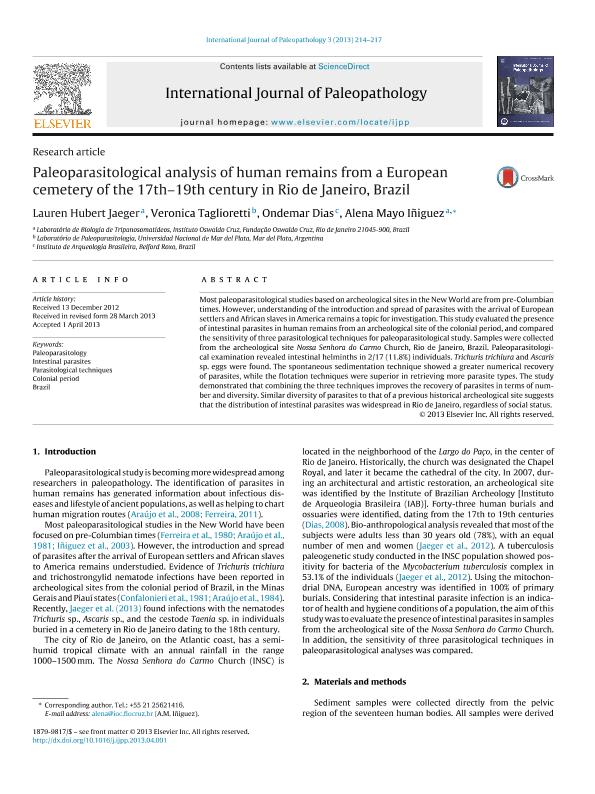Mostrar el registro sencillo del ítem
dc.contributor.author
Jaeger, Lauren Hubert
dc.contributor.author
Taglioretti, Verónica

dc.contributor.author
Dias, Ondermar
dc.contributor.author
Mayo Iñiguez, Alena
dc.date.available
2017-09-27T20:10:56Z
dc.date.issued
2013-04
dc.identifier.citation
Jaeger, Lauren Hubert; Taglioretti, Verónica; Dias, Ondermar; Mayo Iñiguez, Alena; Paleoparasitological analysis of human remains from a European cemetery of the 17th–19th century in Rio de Janeiro, Brazil; Elsevier Science; International Journal of Paleopathology; 3; 3; 4-2013; 214-217
dc.identifier.issn
1879-9817
dc.identifier.uri
http://hdl.handle.net/11336/25264
dc.description.abstract
Most paleoparasitological studies based on archeological sites in the New World are from pre-Columbian times. However, understanding of the introduction and spread of parasites with the arrival of European settlers and African slaves in America remains a topic for investigation. This study evaluated the presence of intestinal parasites in human remains from an archeological site of the colonial period, and compared the sensitivity of three parasitological techniques for paleoparasitological study. Samples were collected from the archeological site Nossa Senhora do Carmo Church, Rio de Janeiro, Brazil. Paleoparasitological examination revealed intestinal helminths in 2/17 (11.8%) individuals. Trichuris trichiura and Ascaris sp. eggs were found. The spontaneous sedimentation technique showed a greater numerical recovery of parasites, while the flotation techniques were superior in retrieving more parasite types. The study demonstrated that combining the three techniques improves the recovery of parasites in terms of number and diversity. Similar diversity of parasites to that of a previous historical archeological site suggests that the distribution of intestinal parasites was widespread in Rio de Janeiro, regardless of social status.
dc.format
application/pdf
dc.language.iso
eng
dc.publisher
Elsevier Science

dc.rights
info:eu-repo/semantics/openAccess
dc.rights.uri
https://creativecommons.org/licenses/by-nc-sa/2.5/ar/
dc.subject
Paleoparasitology
dc.subject
Intestinal Parasites
dc.subject
Parasitological Techniques
dc.subject
Colonial Period
dc.subject
Brazil
dc.subject.classification
Arqueología

dc.subject.classification
Historia y Arqueología

dc.subject.classification
HUMANIDADES

dc.title
Paleoparasitological analysis of human remains from a European cemetery of the 17th–19th century in Rio de Janeiro, Brazil
dc.type
info:eu-repo/semantics/article
dc.type
info:ar-repo/semantics/artículo
dc.type
info:eu-repo/semantics/publishedVersion
dc.date.updated
2017-09-25T18:01:05Z
dc.journal.volume
3
dc.journal.number
3
dc.journal.pagination
214-217
dc.journal.pais
Países Bajos

dc.journal.ciudad
Amsterdam
dc.description.fil
Fil: Jaeger, Lauren Hubert. Instituto Oswaldo Cruz; Brasil
dc.description.fil
Fil: Taglioretti, Verónica. Universidad Nacional de Mar del Plata; Argentina. Consejo Nacional de Investigaciones Científicas y Técnicas; Argentina
dc.description.fil
Fil: Dias, Ondermar. Instituto de Arqueologia Brasileira. Belford Roxo; Brasil
dc.description.fil
Fil: Mayo Iñiguez, Alena. Instituto Oswaldo Cruz; Brasil
dc.journal.title
International Journal of Paleopathology
dc.relation.alternativeid
info:eu-repo/semantics/altIdentifier/url/http://www.sciencedirect.com/science/article/pii/S1879981713000326
dc.relation.alternativeid
info:eu-repo/semantics/altIdentifier/doi/http://dx.doi.org/10.1016/j.ijpp.2013.04.001
Archivos asociados
